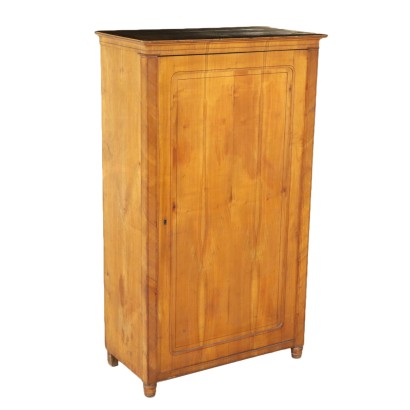Small Wardrobe Cherry Ebony Austria Second Quarter of 1800s
Features
Style: Biedermeier (1815-1848)
Age: 19th Century / 1801 - 1900
Origin: Austria
Material: Cherry Veneer
Description
A small drawer, single door, turned feet. Cherry veneered surface with ebony threads. Manufactured in Austria, second quarter of the 19th century.
Product Condition:
Fair condition. Wear consistent with age and use. Any damage or loss is displayed as completely as possible in the pictures.
Dimensions (cm):
Height: 158
Width: 93
Depth: 48
Additional Information
Style: Biedermeier (1815-1848)
The Biedermeier style is a style that characterizes German and Austrian furniture between approximately 1815 (Congress of Vienna) and 1848 (beginning of the revolutionary movements).Its main features are essentiality and functionality, and the home destination.
Biedermeier first took on a derogatory connotation: the word derives from "Bieder", or "simpleton" and from "Meir", one of the most common German surnames at the time and was the name of a "simpleton" character in a comedy of Ludwig Eichrodt.
This term meant the conservative petty bourgeois, concerned only with his own family reality.
Even if in a derogatory way, the term represents exactly the new socio-political situation in which the bourgeois is forced or resigned to renounce the yearnings for democracy and freedom.
The center of life therefore becomes the home, no longer characterized by unbridled luxury but comfortable and practical.
Consequently, Biedermeier furniture are functional, comfortable and easily achievable products.
The style is an evolution of the Empire style towards greater simplification, without ornamental and antique elements, lighter, linear and curved shapes, lighter colors.
Find out more about the Biedermeier style with our insights:
Biedermeier, the comfortable and practical style
Biedermeier, when a style d 'furniture transforms an environment
FineArt: group eight Biedermeier applique, Vienna, 1820-1830
FineArt: Biedermeier Reifenluster, Vienna, c. 1820-1830 - Viennese chandelier
Age: 19th Century / 1801 - 1900
19th Century / 1801 - 1900Main essence:
Cherry
Obtained from prunus cerasus , a plant of oriental origin, it is a hard wood with a light and delicate color, with a reddish vein. Due to its diffusion and availability it was used in Europe in popular furniture. In cabinet making, in the seventeenth century, it was widely used in France and England for inlay work. In Italy it was very successful in Lucca. It was also very popular in the United States for the manufacture, from the late 1600s, of commonly used furniture.The dictionary of antiques: Eclecticism
Classic Monday: a sofa from the 1800s example of eclecticism
























